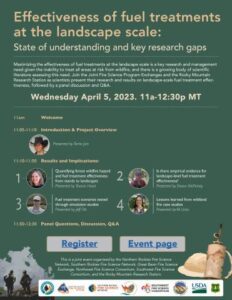Fuels & Fuel Treatments
View report.
This study focused on alternative perspectives of successful fuel break use and the impact of fuel break configurations and management actions on fire risk across a given landscape. This was accomplished using a variety of methods. We used a survey of wildland fire management personnel to gather information on perceptions of fuel break effectiveness, data on fuel break use, and locations of the fuel breaks in question. Input was sought from
managers for fuel breaks throughout California. Managers who were responsible for a specific fuel break or were familiar with suppression operations on a fuel break were eligible to take this survey.
View article.
Our results indicate pinyon jay populations are declining within Bird Conservation Region 16. Jay density was positively associated with sagebrush cover, Palmer Drought Severity Index, and pinyon-juniper cover. Conversely, jay populations were negatively associated with Normalized Difference Vegetation Index (NDVI). We found higher pinyon jay densities within locations possessing both sagebrush and pinyon-juniper cover; conditions characteristic of phase I and II conifer encroachment which are preferentially targeted for conifer removal to restore sagebrush communities. Conifer removal, if conducted at locations with high pinyon jay densities, is therefore likely to negatively affect jay abundance.
Webinar recording.
A recent report, Effectiveness of fuel treatments at the landscape scale: State of understanding and key research gaps, provides key findings from four literature synthesis documents (concepts and fuel treatment effectiveness measurements, empirical, simulation, and case studies) that evaluate the extent to which landscape fuel treatments mitigate adverse effects of wildfire, provide opportunities to manage fire for beneficial effects of wildfire, provide opportunities for cost efficient fire suppression strategies, maximize fire responder safety, provide results to inform future fuel treatment planning, and identify research gaps.
Join the Joint Fire Science Network and Rocky Mountain Research Station for the Landscape Fuel Treatment Effectiveness webinar on Wednesday, April 5 from 11:00 – 12:30 MT.
Four Rocky Mountain Research Station scientists will present their latest research followed by a panel discussion and Q&A.
- Lessons learned from wildland fire case studies | Ali Urza, Research Ecologist
- Quantifying forest wildfire hazard and fuel treatment effectiveness from stands to landscapes | Sharon Hood, Research Ecologist
- Fuel treatment scenarios tested through simulation studies | Jeff Ott, Research Ecologist
- Is there empirical evidence for landscape-level fuel treatment effectiveness? | Shawn McKinney, Writer/Editor
View article.
We developed and applied a spatial optimization algorithm to prioritize forest and fuel management treatments within a proposed linear fuel break network on a 0.5 million ha Western US national forest. The large fuel break network, combined with the logistics of conducting forest and fuel management, requires that treatments be partitioned into a sequence of discrete projects, individually implemented over the next 10–20 years. The original plan for the network did not consider how linear segments would be packaged into projects and how projects would be prioritized for treatments over time, as the network is constructed. Using our optimization algorithm, we
analyzed 13 implementation scenarios where size-constrained projects were prioritized based on predicted wildfire hazard, treatment costs, and harvest revenues.
View article.
Qualifying studies focused primarily but not exclusively on forested landscapes of the western USA and ranged in size from 200 to 3,400,000 ha. Most studies showed that scenarios with fuel reduction treatments had lower levels of wildfire compared to untreated scenarios. Damaging wildfire types decreased while beneficial wildfire increased as a result of treatments in most cases where these were differentiated. Wildfire outcomes were influenced by five dimensions of treatment design (extent, placement, size, prescription, and timing) and other factors beyond the treatments (weather, climate, fire/fuel attributes, and other management inputs). Studies testing factorial combinations showed that the relative importance of these factors varied across landscapes and contexts.
We systematically selected and reviewed 20 thinning studies to analyze key variables affecting machine productivity and harvesting costs. The average cost of forest thinning was lowest for a mechanized whole-tree thinning operation at $21.34/ton or $2,075/ha. Feller-bunchers and skidders showed the highest productivity in felling and extraction machines, respectively.
View article.
In this forum paper we briefly review current knowledge of common fuel treatment approaches, their intended benefits, potential risks, and limitations. We additionally discuss challenges for fuel treatment strategies in the context of changes in climate, invasive species, wildlife habitat, and human population, and we explore how advances in geospatial technologies, monitoring, and fire behavior modeling, as well as accounting for social context, can improve the efficacy of fuels management in sagebrush ecosystems. Finally, given continued potential for ecosystem transformation, we describe approaches to future fuels management by considering the applicability of the Resist-Accept-Direct (RAD) framework. The intent of the paper is to provide scientists and land managers with key information and a forward-thinking framework for fuels science and adaptive management that can respond to both expected and unexpected changes in sagebrush rangelands.
View article.
Fuel treatments can substantially reduce smoke emission from subsequent wildfires and if located in consideration of meteorological patterns, these fuel treatments can reduce ambient concentrations of PM2.5.
View article.
Evaluating the cumulative ability of fuel treatments to change landscape patterns of fire behavior and effects is challenging. By quantifying fire hazard, followed by evaluating outcomes of wildfires on environmental and ecological indicators and social values, it becomes possible to assess how individual fuel treatments placed within the context of a fuel management regime are effective based on desired conditions that address management objectives. This conceptual framework offers a much-needed middle-ground planning, monitoring, and reporting approach between overly simplistic annual reporting summaries of the area treated, number of fires, and burned area and detailed fire simulation modeling outcomes by putting individual treatments and fires in the context of current and desired vegetative conditions and social values. Our fuel treatment effectiveness framework examines the state of fuels through the lens of fire hazard and connects fuels to subsequent fire behavior and effects over time and space. The framework provides a way to focus regional and national fuel management planning efforts toward creating fuel management regimes that increase social and ecological resilience from wildfire.
View article.
Seventeen of the 18 case studies occurred in the western United States, and all were primarily focused on forested ecosystems. Surface fire behavior was more commonly observed in areas treated for fuel reduction than in untreated areas, which managers described as evidence of treatment effectiveness. Reduced fire intensity diminished fire effects and supported fire suppression efforts, while offering the potential to use wildfires as a fuel treatment surrogate.




